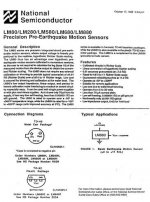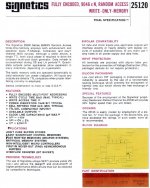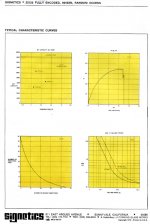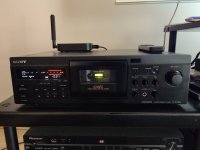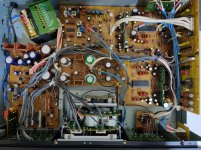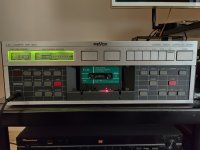I was trying swapping the NE5532 Studer head amps for a polish LM0901A1411090451C with mixed results. Strange thing, those polish OP amps.
Looks like a winner.
I was trying swapping the NE5532 Studer head amps for a polish LM0901A1411090451C with mixed results. Strange thing, those polish OP amps.
A post for April 1? It looks like a tweaked National Semiconductor datasheet.
Last edited:
Yes, NS datasheet. They were in lincense production it seems. But the sheet is dated march....maybe I picked fakes of this wonderful design.A post for April 1? It looks like a tweaked National Semiconductor datasheet.
Last edited:
> More stuff for April 1...
Actually that LM80 sheet is 5:04pm 19 October of some year.
1989 Loma Prieta earthquake - Wikipedia
Actually that LM80 sheet is 5:04pm 19 October of some year.
1989 Loma Prieta earthquake - Wikipedia
For DIY, not much difference in price between LM4562 & NE5532 in 8 pin DIP... For production that is a different story.
https://www.mouser.com/ProductDetail/Texas-Instruments/LM4562MAX-NOPB?qs=QbsRYf82W3Ezhxi4DELIgw==
LM4562NA/NOPB for $1.86, one each
https://www.mouser.com/ProductDetail/Texas-Instruments/NE5532AP?qs=j01uVdFEFjGsFkE81lY84w==
NE5532AP for $1.26, one each
https://www.mouser.com/ProductDetail/Texas-Instruments/LM4562MAX-NOPB?qs=QbsRYf82W3Ezhxi4DELIgw==
LM4562NA/NOPB for $1.86, one each
https://www.mouser.com/ProductDetail/Texas-Instruments/NE5532AP?qs=j01uVdFEFjGsFkE81lY84w==
NE5532AP for $1.26, one each
I see that ADA4075-2 has 3 times higher current noise and 15 times higher input bias current than opa2228, just unity gain stable which tape PB and phono preamps don't really need...From a noise perspective opa2228 should be technically better...
Was still holding for non intrusive hiss with the ADA4075-2 (1.2pArtHz), until with the ADA4898-2 (2.4pArtHz) it started to appear. Although with the OPA2228 (0.4pArtHz) things were quietest and tonally lush, there was also some lack of snap in the treble I thought. OPA2156 CMOS was doing a fine job also, although kind of dark in the pb position. But did a great job as rec input buffer. OPA1642 and ADA4625-2 JFET types were good in the pb head amp position too but kinda cold in details tone.
*0.1uF cross rails decoupling film caps were installed under all op-amp positions. All signal path back to back polar caps were replaced with modern Nichicon bipolars. Polar UKZ UFG used in other places too. Muting transistors negative bias headroom mod was also done.
Attachments
@Salas
While noise wouldn't probably be a big problem with vinyl or tape medium, I used OPA2228 in Pioneer CT777 myself...I doubt the compensated PB tapehead in Sony has much better slew rate than the one in Pioneer, while removing SONY's dolby S section the signal path isn't more straightforward than Pioneer's either.When using the OPA2228 with Shure v15type 3 it sounds snappier than my Luxman CL34 clone with 12ax7 and 12bh7 up to the point where i suspect my Taylor phono preamp(which is also free of common mode distortions) of being a little unstable...The dust on OPA2228 is also the most annoying probably due to hard clipping when hitting the rails, but other than that i had the impression of OPA2228 being damn fast for phono operation. I highly doubt that either tapeheads or mm cartridges can be faster than OPA2228, while the recording medium itself is definitely slower then 10v/us and i don't see a a big difference to 12v/us of ADA4075. GBW of ADA is 5 times smaller while its open loop gain looks smaller too but its unity gain stable, settling time is higher too in ADA compensated chip so ada4075 looks slower than opa2228 to me ...There's no data to support a faster ADA 4075...but our ears can be tricked in may ways.The compensated version, OPA2227 is indeed much slower, but some people seem to be perfectly happy with it too..
While noise wouldn't probably be a big problem with vinyl or tape medium, I used OPA2228 in Pioneer CT777 myself...I doubt the compensated PB tapehead in Sony has much better slew rate than the one in Pioneer, while removing SONY's dolby S section the signal path isn't more straightforward than Pioneer's either.When using the OPA2228 with Shure v15type 3 it sounds snappier than my Luxman CL34 clone with 12ax7 and 12bh7 up to the point where i suspect my Taylor phono preamp(which is also free of common mode distortions) of being a little unstable...The dust on OPA2228 is also the most annoying probably due to hard clipping when hitting the rails, but other than that i had the impression of OPA2228 being damn fast for phono operation. I highly doubt that either tapeheads or mm cartridges can be faster than OPA2228, while the recording medium itself is definitely slower then 10v/us and i don't see a a big difference to 12v/us of ADA4075. GBW of ADA is 5 times smaller while its open loop gain looks smaller too but its unity gain stable, settling time is higher too in ADA compensated chip so ada4075 looks slower than opa2228 to me ...There's no data to support a faster ADA 4075...but our ears can be tricked in may ways.The compensated version, OPA2227 is indeed much slower, but some people seem to be perfectly happy with it too..
Last edited:
I used the OPA2227 as output amp in the KA6ES. Its doing a good job there. Decks are complex systems with many synergies and some surprise preferences may occur. Mechanical issues and alignment must be fully corrected before even going to the electronics. One of the more complex decks that I repaired is the B215. Was refusing to record. A logic circuits issue in the end. Surprisingly it manages a very good initial subjective result with stock slow RC4559 op amps on a recap only. The medium is not strictly demanding fast. Almost a hundred of new caps went in.
Attachments
Worst reasoning ever. Like we are in DIY audio because it is cheaper to DIYKeep dreaming the dream, shut all windows and avoid getting to know newer parts. Declare them unnecessary before you even get your hands on them.
Some people even never try and just simply justify. Sound is not 100% percent measurement. The most important in music listening is dynamic behaviour like transient and slew rate. This area often a very good measured part will fail with other competitor. The best to identify the sound transient behaviour is your ear and try as much as possible sample and compare it.
I have tried so many Op amp, but some Op amp which is not designed for audio like AD826, AD827, AD828 sound very good. LM4562, OPA2604, OPA2134 is also very good. NE5532, NJM2043, NJM2068 are is same class.
I think the higher cost is due to it being screened for guaranteed noise performance (including 1/f noise), well at least for the NE5534A variants. As I understand it the 5532 is basically the same chip with altered compensation, but the specs are noisier because its not screened on a die-by-die basis.Looks like the price of ne5534 was artificially raised to sell more lm4562...
To screen for 1/f noise takes time due to the low bandwidths involved, increasing the manufacturing overhead.
Noise screening makes more sense for a single opamp than a dual version since you don't have to junk a die if only part of it is sub-standard.
Why have you created a new account, after specifically saying you wished to leave, and after asking to have your previous account disabled, which we did for you?Some people even never try and just simply justify. Sound is not 100% percent measurement. The most important in music listening is dynamic behaviour like transient and slew rate. This area often a very good measured part will fail with other competitor. The best to identify the sound transient behaviour is your ear and try as much as possible sample and compare it.
I have tried so many Op amp, but some Op amp which is not designed for audio like AD826, AD827, AD828 sound very good. LM4562, OPA2604, OPA2134 is also very good. NE5532, NJM2043, NJM2068 are is same class.
- Home
- Source & Line
- Analog Line Level
- Drop in replacement for NE5532?
